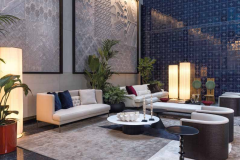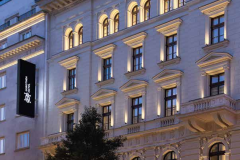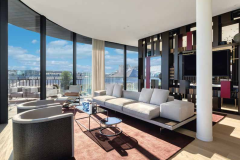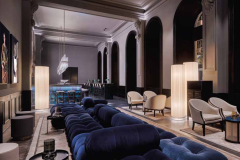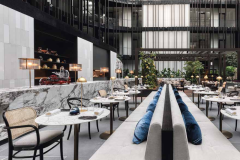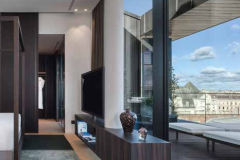A Mosaic of Urban History
Dorothea Hotel, Budapest
Architecture: TSPC
Interiors: Lissoni & Partners
Text: György Szegő
Photos: Dorothea Hotel / George Fakaros Vision Required
The block next to Vörösmarty Square in Budapest, which has now grown together as the Dorothea Hotel, bears traces of very different architectural and cultural eras. It combines a historic environment with contemporary spaces to create a top-class hotel with 216 luxury rooms and suites. It also houses elite apartments that are still in the process of being developed. With the redevelopment project, the block has been renovated on 7 levels, covering 35 000 square metres. It is a demanding achievement in terms of services and their extreme visual refinement, but at the same time a complex one, involving the protection of the built heritage and the conservation of historic monuments. Guests enter the hotel through an antique Neo-Renaissance-style portico: under a ceiling decorated with original stone rosettes, the walls are graced with the portrait-like paintings of the photographer and fashion photographer Zoltán Tombor. Moving on from the former courtyard, the reception area appears under a monumental drop-shaped chandelier. Behind it, on the wall, there is a huge stone relief “carved” with high-tech technology. On the level above the grand mural, the reception opens up into an airy courtyard surrounded by three buildings and covered by a light glass roof. This oasis is the hotel’s breakfast room, one of its restaurants and a bar. The new hotel block spans two levels, embracing the casino on Vigadó Street, which is being removed from the present development and on which the courtyard has been built. On the other side, the reception and the other restored cast-iron column, red-brick main staircase connecting the floors are wedged in. The exterior is characterised by a gesture that preserves the original state. The compositional surfaces that connect the covered courtyard facades of the building interiors: the glass facades and their louvres. Behind them, a large part of the rooms are located. The Presidential Suite on the top floor is a highlight, with a decor that is over the top in style and reminiscent of Japanese design patterns.
Developer: BDPST Group
General planning: TSPC
Architecture: TSPC
Leading architect: Mihály Kádár
Project manager: Balázs Balla
Project architects: Gábor Rónaszéki, Andrea Tóth-Lovrity
Architects: Márton Bán, Sándor Cseke, Mónika Fenyvesvölgyi, Péter Gönye, Hunor Harsányi, Sarolta Hegedüs-Kolozsi, Enikő Hitró, Lilla Kocsis-Romhányi, Bence Seszták, Eszter Seszták-Lazúr
BIM management: Gábor Nagy, Károly Bélafi
Interiors: Mattia Susani, Tania Zaneboni, Rodrigo Tellez – Lissoni & Partners
Structure: Gábor Cséfalvay, Gábor Szaniszló – Tetra-Plan
HVAC: Tamás Vörös, József Szedlacsek – Perfect-Plan
Electrical engineering: György Kapitor, Miklós Havasi – Zone-Plan
Building automatics: Gyula Kerek, László Paragi– IBMS-PLAN
Fire protection: Bálint Molnár, István Bihari – TSPC
Kitchen technology: Alexandra Rétfalvi-Kurucz, Gizella Kuruczné Szabolcs – Design Stúdió
Accessibility: András József Pandula – NT Control
Roads, traffic: Péter Geri, Bálint Kiss – TSPC
Acoustics: Róbert Csott – ’95 APSZIS
Pool technology: Zsolt Eördög – Mecsekterv
Framework: Károly Nagy – Épszerkinfo
Sprinkler: Gergely Bánó – Dunamenti Tűzőr
Elevators: Boglárka Odonics, László Pápai – OTIS
Security, health and work protection: Krisztián Pék
Garden, landscape, watering: Helga Hencz – Kertművek
Public utilitites: Ákos Szova, Szabina Spagina, Péter Karizs – TSPC
Telecommunications: József Galambos – HHT’998
Outdoor public utilities: Balázs Aszalós – Electric Future Plan
Underground construction: András Ament – AA4

